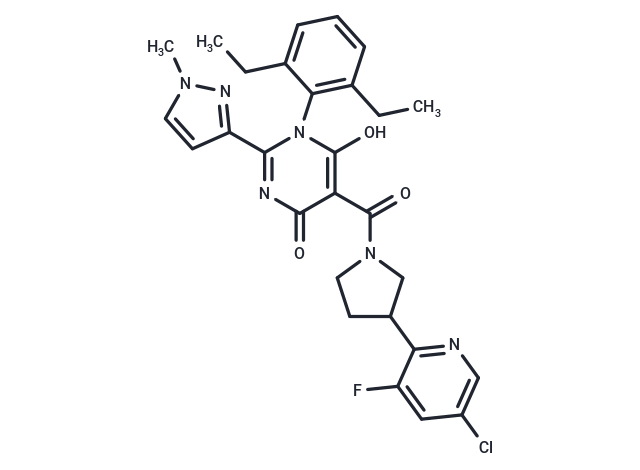Shopping Cart
Remove All Your shopping cart is currently empty
Your shopping cart is currently empty
APJ Receptor Agonist 4 is a potent, orally active apelin receptor (APJ) agonist, demonstrating an EC50 of 0.06 nM and a Ki of 0.07 nM. It exhibits excellent pharmacokinetic profiles in rodent heart failure (HF) models and has shown an acceptable safety profile in preclinical toxicology studies. This compound effectively improves cardiac function, making it valuable for research into HF disease.

| Pack Size | Price | USA Warehouse | Global Warehouse | Quantity |
|---|---|---|---|---|
| 5 mg | $1,270 | Inquiry | Inquiry |
| Description | APJ Receptor Agonist 4 is a potent, orally active apelin receptor (APJ) agonist, demonstrating an EC50 of 0.06 nM and a Ki of 0.07 nM. It exhibits excellent pharmacokinetic profiles in rodent heart failure (HF) models and has shown an acceptable safety profile in preclinical toxicology studies. This compound effectively improves cardiac function, making it valuable for research into HF disease. |
| In vivo | This study evaluates the pharmacokinetics (PK) profile of APJ receptor agonist 4 (compound 21) across different species, including mice, rats, monkeys, and dogs. For each species, the research illustrates the maximum plasma concentration (Cmax), dose administered (both intravenously [i.v.] and orally [p.o.]), clearance (CI), steady-state volume of distribution (Vss), half-life (T1/2), the peak concentration time (Cmax) in µM?h, and area under the curve (AUC) from 0 to 24 hours in µM?h. The dosing varied, with 1 mg/kg for both routes in mice, 1 mg/kg (i.v.) and 3 mg/kg (p.o.) in rats, and identical dosing for monkeys and dogs. Two vehicles were used for compound administration: Vehicle F (5/5/90 v/v/v DMAC/Cremophor EL/sodium carbonate buffer, pH 9) and Vehicle G (10/40/50 v/v/v ethanol/PEG400/sodium carbonate buffer, pH 9), affecting the bioavailability (F%) across species—54% in mice, 27% in rats, and 76% in dogs. The study provides a comparative analysis of how compound 21's absorption, distribution, metabolism, and excretion characteristics vary among different animal models. |
| Molecular Weight | 551.02 |
| Formula | C28H28ClFN6O3 |
| Cas No. | 2135515-67-0 |
| Smiles | CCc1cccc(CC)c1-n1c(O)c(C(=O)N2CCC(C2)c2ncc(Cl)cc2F)c(=O)nc1-c1ccn(C)n1 |
| Storage | Powder: -20°C for 3 years | In solvent: -80°C for 1 year | Shipping with blue ice/Shipping at ambient temperature. |
| Size | Quantity | Unit Price | Amount | Operation |
|---|

Copyright © 2015-2026 TargetMol Chemicals Inc. All Rights Reserved.